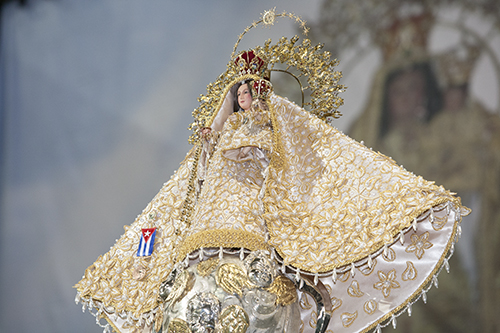
Cover us with your mantle!
Monday, September 5, 2016
*Rogelio Zelada
After describing the scene where the angel Gabriel announces to Mary that God has chosen her for the important mission of being the bridge where God and man meet, to start the important work of redemption, St. Luke tells us that she immediately went on her way to the house of her elderly cousin — a visit driven by faithfulness to God, who had given her a sign: the humanly impossible pregnancy of Elizabeth. It was a sign that she, in obedience, needed to verify; not to mention the great physical help she could provide during those last three months of John’s gestation.
The evangelist has described a brave, outstanding woman who speaks face to face with God, and who makes personal decisions without waiting for the approval of a male figure, as was the expectation back then. Her story begins in the context of the extraordinary, where a foolproof fidelity turns Mary of Nazareth into a model for every believer willing to second God’s plans, even without understanding anything or almost nothing about what the Lord has in mind.

Photographer: ANA RODRIGUEZ-SOTO | FC
Image of Our Lady of Charity, Cuba's patroness, at the Bank United Center during the annual Mass on her feast day, Sept. 8.
Similarly, that is how Mary enters in the history of our people. As she did with Elizabeth, she has also come to visit us. But not like a quick doctor’s visit or out of obligation, but a real family visit. She has stayed to listen, to comfort us, to share our sorrows and our joys, to be at our side at all times and everywhere.
That is how they found her, serenely floating on the water after the storm. She came to Cuba as a celestial missionary rafter, a balsera, standing on a fragile piece of timber, a delicate miracle of God's providence. And she not only came to visit but to stay for all events of a budding people who were just beginning to become that.
She shared the poverty and helplessness of our peasants; the pain of mothers whose children lost their lives for the freedom of their motherland. She held the hope of the rafters who faced the fierce waters separating Cuba from freedom and continues to encourage us in all paths leading to faith in the Lord, the only savior.
From the Bay of Nipe, our holy Virgin of Charity rose to the mountains of El Cobre and, from there, to the homes and lives of all Cubans. She marched with the liberators to the redemptive mountain (manigua), and every mambí kept her picture in the pocket of his shirt and her name on his lips when marching to battle for the freedom of Cuba.
As slight as the poor of the land and as mestiza as her people, her mixed race image tells us again and again with all the strength of her love, “Do whatever He tells you,” pointing to the child she carries in her arms. There is only one sure way to freedom and life, and that way is to follow the Gospel, to live the Gospel, to preach the Gospel. And along that path where faith takes us, we only need to trust and to wait against all hope. That is how she affirms that we are not alone on this journey because she, the Blessed Virgin Mary of Charity, accompanies us every day.
Her image arrived as another exile to Miami’s shores, guarded by a political exile and just in time to join the first major Eucharistic celebration for Cubans. There she showed to the American episcopate the barrage of newly arrived sons and daughters searching for freedom, peace, and a future. Thirty thousand Catholics gathered for her feast, with the bread of hope contained in their hearts and the joy of having Our Lady of Charity as mother and encouragement at a time and along a path that was just beginning. She stayed here, in the Shrine by the sea, to lavish love and comfort upon all, to welcome the recently arrived, the one who is in trouble, the one who is ill or homesick, and the one who wants to give thanks for so many joys and gifts.
The doors of the National Shrine of Our Lady of Charity were opened not only for her Cuban children but also for all believers and the faithful of all nations in the Americas. To her have been born children of all colors and ways of thinking, rich and poor, who come to prostrate themselves at the feet of her image, grateful to the dark-skinned virgin who stretches out her mantle to embrace them all.
As in the wedding at Cana, on this day she implores her Son: "Cubans lack the wine of hope; they need encouragement, they need to return to spiritual values. Do not allow them to go without joy or without the gift of solidarity; do not let them forget their roots or allow distance and time to embitter their hearts or erase their memories."
Last year, all Cubans garbed themselves with joy to celebrate the 100th anniversary of the petition to Pope Benedict XV, made by the Veterans of the Cuban Liberation Army – the mambises –, to declare the Virgin of Charity as heavenly patroness of Cuba. It was also a time of preparation for the great centenary of 2016 when we celebrate the first century of the Church’s official statement proclaiming the patronage of the Virgin Mambisa over all Cubans — official recognition of what, in fact, had been for centuries a reality in the heart of an entire faithful people.
The Virgin of Charity came four centuries ago to visit a people and to stay with them. As a tireless visitor, the Virgin toured the entire island in 1902 to celebrate the centenary of the Cuban republic. She returned to tour it again and reawaken a faith that seemed asleep when she visited every city, every village, every batey, every chapel and every parish to announce and prepare the visit of the aged Pope John Paul II. Small and quiet, but firm, tenacious and bold, she kept alive the embers of a faith that could not be snuffed out by any of the storms that struck the Cuban people. Not even the fiercest atheistic campaign of the communist government could remove her from the depths of the hearts of her children who proclaim, along with St. Elizabeth, “Blessed are you among women and blessed is the fruit of your womb!”
Holy Virgin of Charity, hear the people whom you have come to visit and who once again implore you with confidence: Hasten for your Cuba the hour of truth, freedom, and justice!

